Experimental Results of Partial Discharge Localization in Bounded Domains
Abstract
1. Introduction
- TDOA is the time required by the signal to propagate from a reference receiver, that is, , to the i-th receiver . Mathematically, this concept is expressed with the measurement modelwhere is the source location, is the distance between the source and the i- receiver, while is the signal arrival time in .
- the RSS is based on the average EM radiation power emitted by the source and detected at receivers locations. The RSS measurement model for a single receiver is [16,17]where is the average power measured by the i- receiver, is the average power transmitted by the source, is the path loss exponent (in free space: ) and is a constant. In PD localization applications, terms and in (2) are unknown. In order to overcome this issue, it is sufficient to set a reference receiver (i.e., located in ). In this way, the average received power in is related to the received power in according withwhere is the average power measured by the reference receiver.
2. Method
- and are the electric and magnetic field vectors;
- and are the electric and magnetic source vectors;
- is the unit dyadic;
- BCs and ICs are the Boundary and Initial Conditions;
- the quantities:are the linear spatial operators respectively for the electric and magnetic field. In (5) the magnetic permeability and the electric permittivity are in general tensor quantities.
2.1. Ill-Posedness and Regularization
2.2. Localization Accuracy
3. Experimental Setup
3.1. Partial Discharge Generation
- a 100 / 30 MV Voltage Transformer (VT), which low voltage terminal is fed by a source operating in the range ;
- a 100 resistor damping R in order to limit the output current in case of total discharge;
- a PD Generator (PDG) custom designed and realized to generate artificial PDs such as Corona, internal or surface discharges in a well defined volume. It allows the electric stress control according to different electrodes shapes and distances (d and d) and eventually with the usage of different dielectric media (Figure 2). The PDG characteristics are reported in Figure 2b.
- a MV power cable connecting the VT and PDG. The cable is a single phase, custom designed by with double shields and rated voltage of 45 AC. The cable termination is ad-hoc realized in order to reduce the electric stress and limit the unwanted PD activity. The cable cross section is shown in Figure 3, while the cable mechanical details are reported in Figure 3b.
- a metal-enclosure emulates the bounded domain under test. Its internal volume contains the MV power supply cable and the PDG. The enclosure is a , made of Aluminum and filled by air at room temperature, pressure and humidity. The cable entry is located exactly above the PDG, ensuring an adequate distance from the enclosure surfaces, in order to avoid fault events. Figure 4 shows the internal metal-enclosure volume.
3.2. Partial Discharge Detection
3.3. Noise Sources
- measurement acquisition system and environment;
- communication systems (i.e., mobile communication), radio and TV broadcasting;
- periodic switching operations (i.e., power electronics valves commutations);
- stochastic events (i.e., lightning, circuit breaker trips).
3.4. Electromagnetic Model
4. Results
4.1. Test Case 1
4.2. Test Case 2
5. Conclusions
Author Contributions
Funding
Institutional Review Board Statement
Informed Consent Statement
Data Availability Statement
Conflicts of Interest
References
- Bartnikas, R. Partial discharges. Their mechanism, detection and measurement. IEEE Trans. Dielectr. Electr. Insul. 2002, 9, 763–808. [Google Scholar] [CrossRef]
- Van Brunt, R.J. Stochastic properties of partial-discharge phenomena. IEEE Trans. Electr. Insul. 1991, 26, 902–948. [Google Scholar] [CrossRef]
- Niemeyer, L. A generalized approach to partial discharge modeling. IEEE Trans. Dielectr. Electr. Insul. 1995, 2, 510–528. [Google Scholar] [CrossRef]
- Schwarz, R.; Muhr, M. Modern technologies in optical partial discharge detection. In Proceedings of the Annual Report—Conference Electrical Insulation and Dielectric Phenomena, Vancouver, BC, Canada, 14–17 October 2007; pp. 163–166. [Google Scholar] [CrossRef]
- Luo, G.; Zhang, D. Study on performance of HFCT and UHF sensors in partial discharge detection. In Proceedings of the 2010 Conference Proceedings IPEC, Singapore, 27–29 October 2010; pp. 630–635. [Google Scholar] [CrossRef]
- Álvarez, F.; Garnacho, F.; Ortego, J.; Sánchez-Urán, M. Application of HFCT and UHF sensors in on-line partial discharge measurements for insulation diagnosis of high voltage equipment. Sensors 2015, 15, 7360–7387. [Google Scholar] [CrossRef]
- Luo, Y.; Li, Z.; Wang, H. A review of online partial discharge measurement of large generators. Energies 2017, 10, 1694. [Google Scholar] [CrossRef]
- Álvarez Gómez, F.; Albarracín-Sánchez, R.; Garnacho Vecino, F.; Granizo Arrabé, R. Diagnosis of insulation condition of MV switchgears by application of different partial discharge measuring methods and sensors. Sensors 2018, 18, 720. [Google Scholar] [CrossRef]
- IEC60270:2000+AMD1:2015 CSV. High-Voltage test Techniques—Partial Discharge Measurements; Standard, International Organization for Standardization: Geneva, Switzerland, 2000. [Google Scholar]
- IEC TS 62478:2016. High Voltage Test Techniques—Measurement of Partial Discharges by Electromagnetic and Acoustic Methods; Standard, International Organization for Standardization: Geneva, Switzerland, 2016. [Google Scholar]
- Li, Z.; Luo, L.; Zhou, N.; Sheng, G.; Jiang, X. A novel partial discharge localization method in substation based on a wireless UHF sensor array. Sensors 2017, 17, 1909. [Google Scholar] [CrossRef]
- Li, X.; Deng, Z.D.; Rauchenstein, L.T.; Carlson, T.J. Contributed Review: Source-localization algorithms and applications using time of arrival and time difference of arrival measurements. Rev. Sci. Instrum. 2016, 87, 041502. [Google Scholar] [CrossRef]
- Lu, Y.; Tan, X.; Hu, X. PD detection and localisation by acoustic measurements in an oil-filled transformer. Meas. Technol. IEE Proc. Sci. 2000, 147, 81–85. [Google Scholar] [CrossRef]
- Mohamed, H.; Lazaridis, P.; Upton, D.; Khan, U.; Mistry, K.; Saeed, B.; Mather, P.; Vieira, M.F.Q.; Barlee, K.W.; Atkinson, D.S.W.; et al. Partial discharge localization based on received signal strength. In Proceedings of the 23rd International Conference Automation and Computing (ICAC), Huddersfield, UK, 7–8 September 2017; pp. 1–4. [Google Scholar] [CrossRef]
- Khan, U.F.; Lazaridis, P.I.; Mohamed, H.; Albarracín, R.; Zaharis, Z.D.; Atkinson, R.C.; Tachtatzis, C.; Glover, I.A. An Efficient Algorithm for Partial Discharge Localization in High-Voltage Systems Using Received Signal Strength. Sensors 2018, 18, 4000. [Google Scholar] [CrossRef]
- Friis, H.T. A Note on a Simple Transmission Formula. Proc. IRE 1946, 34, 254–256. [Google Scholar] [CrossRef]
- Rappaport, T.S. Wireless Communications—Principles and Practice, (The Book End); Prentice Hall: Upper Saddle River, NJ, USA, 2002. [Google Scholar]
- Stone, G.C. Partial discharge. VII. Practical techniques for measuring PD in operating equipment. IEEE Electr. Insul. Mag. 1991, 7, 9–19. [Google Scholar] [CrossRef]
- Tenbohlen, S.; Denissov, D.; Hoek, S.M.; Markalous, S. Partial discharge measurement in the ultra high frequency (UHF) range. IEEE Trans. Dielectr. Electr. Insul. 2008, 15, 1544–1552. [Google Scholar] [CrossRef]
- Wagenaars, P.; Wouters, P.; Van Der Wielen, P.; Steennis, E. Accurate estimation of the time-of-arrival of partial discharge pulses in cable systems in service. IEEE Trans. Dielectr. Electr. Insul. 2008, 15, 1190–1199. [Google Scholar] [CrossRef]
- Sinaga, H.H.; Phung, B.T.; Blackburn, T.R. Partial discharge localization in transformers using UHF detection method. IEEE Trans. Dielectr. Electr. Insul. 2012, 19, 1891–1900. [Google Scholar] [CrossRef]
- Fresno, J.M.; Robles, G.; Martínez-Tarifa, J.M.; Stewart, B.G. Survey on the Performance of Source Localization Algorithms. Sensors 2017, 17, 2666. [Google Scholar] [CrossRef]
- Portugues, I.; Moore, P.; Glover, I. The effect of multipath in time domain characterization of partial discharges. In Proceedings of the 7th International Conference on Properties and Applications of Dielectric Materials (Cat. No. 03CH37417), Nagoya, Japan, 1–5 June 2003; Volume 1, pp. 311–314. [Google Scholar] [CrossRef]
- D’Antona, G.; Perfetto, L. Eigenfunction expansion method for partial discharge localization in a bounded domain. In Proceedings of the 2018 IEEE International Instrumentation and Measurement Technology Conference (I2MTC), Houston, TX, USA, 14–17 May 2018; pp. 1–6. [Google Scholar] [CrossRef]
- D’Antona, G.; Perfetto, L. Partial Discharge Localization in Insulated Switchgears by Eigenfunction Expansion Method. IEEE Trans. Instrum. Meas. 2019, 68, 1294–1301. [Google Scholar] [CrossRef]
- Perfetto, L. Partial Discharges Diagnostics: Localization in Complex Bounded Domains. Ph.D. Thesis, Politecnico di Milano, Milan, Italy, 2019. [Google Scholar]
- Hanson, G.W.; Yakovlev, A.B. Operator Theory for Electromagnetics: An Introduction; Springer Science & Business Media: Berlin/Heidelberg, Germany, 2013. [Google Scholar]
- Balanis, C.A. Advanced Engineering Electromagnetics; John Willey & Sons: Hoboken, NJ, USA, 1989. [Google Scholar]
- Menke, W. Geophysical Data Analysis: Discrete Inverse Theory; Academic Press: Cambridge, MA, USA, 2018. [Google Scholar]
- Groetsch, C.W.; Groetsch, C. Inverse Problems in the Mathematical Sciences; Springer: Berlin/Heidelberg, Germany, 1993; Volume 52. [Google Scholar]
- Hadamard, J. Sur les problèmes aux dérivées partielles et leur signification physique. Princet. Univ. Bull. 1902, 13, 49–52. [Google Scholar]
- Hansen, P.C.; O’Leary, D.P. The use of the L-curve in the regularization of discrete ill-posed problems. SIAM J. Sci. Comput. 1993, 14, 1487–1503. [Google Scholar] [CrossRef]
- Golub, G.H.; Von Matt, U. Generalized cross-validation for large-scale problems. J. Comput. Graph. Stat. 1997, 6, 1–34. [Google Scholar] [CrossRef]
- Casella, G.; Berger, R.L. Statistical Inference; Duxbury Press: Pacific Grove, CA, USA, 2002; Volume 2. [Google Scholar]
- Rohde-Schwarz. Available online: https://www.rohde-schwarz.com (accessed on 1 December 2020).
- Balanis, C.A. Antenna Theory: Analysis and Design; John Wiley & Sons: Hoboken, NJ, USA, 2016. [Google Scholar]
- Tang, Z.; Li, C.; Cheng, X.; Wang, W.; Li, J.; Li, J. Partial discharge location in power transformers using wideband RF detection. IEEE Trans. Dielectr. Electr. Insul. 2006, 13, 1193–1199. [Google Scholar] [CrossRef]
- Albarracín, R.; Ardila-Rey, J.; Mas’ud, A. On the use of monopole antennas for determining the effect of the enclosure of a power transformer tank in partial discharges electromagnetic propagation. Sensors 2016, 16, 148. [Google Scholar] [CrossRef]
- Robles, G.; Sánchez-Fernández, M.; Sánchez, R.A.; Rojas-Moreno, M.V.; Rajo-Iglesias, E.; Martínez-Tarifa, J.M. Antenna parametrization for the detection of partial discharges. IEEE Trans. Instrum. Meas. 2012, 62, 932–941. [Google Scholar] [CrossRef]
- Robles, G.; Martínez-Tarifa, J.M.; Rojas-Moreno, M.V.; Albarracín, R.; Ardila-Rey, J. Antenna selection and frequency response study for UHF detection of partial discharges. In Proceedings of the IEEE Int Instrumentation and Measurement Technology, Graz, Austria, 13–16 May 2012; pp. 1496–1499. [Google Scholar] [CrossRef]
- Keysight. Available online: https://www.keysight.com (accessed on 1 December 2020).
- Cavallini, A.; Contin, A.; Montanari, G.C.; Puletti, F. Advanced PD inference in on-field measurements. I. Noise rejection. IEEE Trans. Dielectr. Electr. Insul. 2003, 10, 216–224. [Google Scholar] [CrossRef]
- Happe, S.; Kranz, H.; Krause, W. Advanced suppression of stochastic pulse shaped partial discharge disturbances. IEEE Trans. Dielectr. Electr. Insul. 2005, 12, 265–275. [Google Scholar] [CrossRef]
- Saha, T.K.; Purkait, P. Transformer Ageing: Monitoring and Estimation Techniques; Wiley: Hoboken, NJ, USA, 2017. [Google Scholar]
- Clarkson, P.M. Optimal and Adaptive Signal Processing; CRC Press: Boca Raton, FL, USA, 2017. [Google Scholar]
- Comsol Multiphysics. Available online: https://www.comsol.eu (accessed on 1 December 2020).
- Matlab. Available online: https://www.mathworks.com (accessed on 1 December 2020).


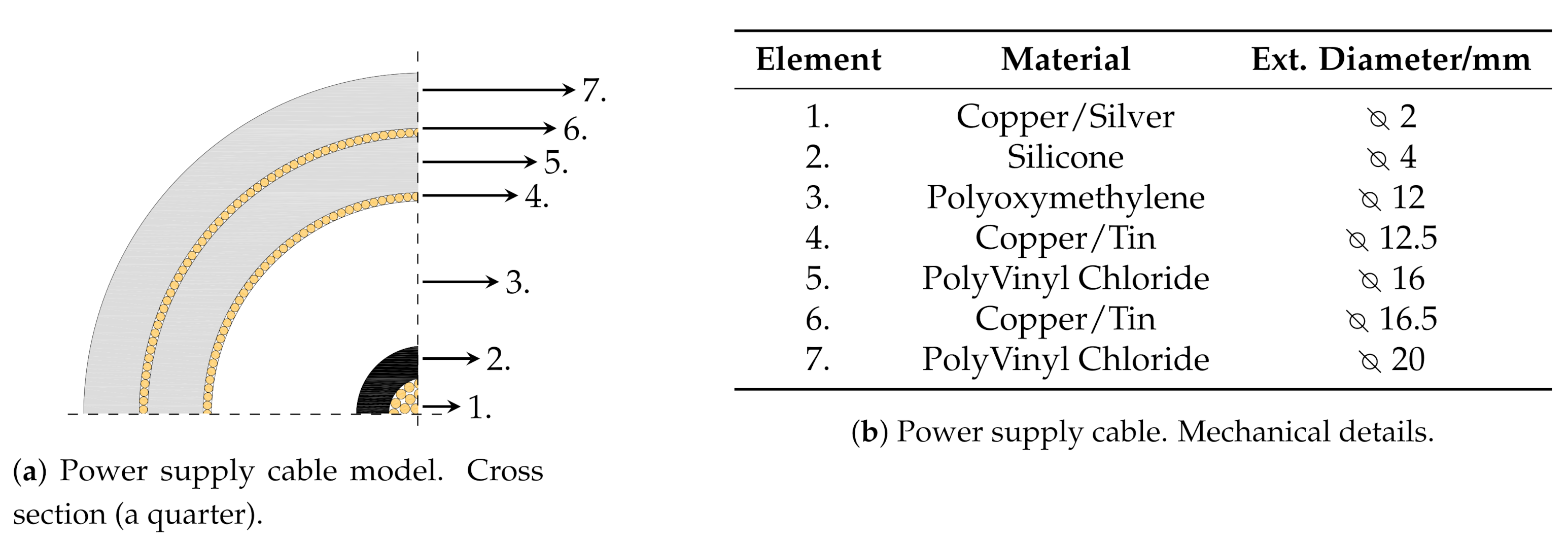

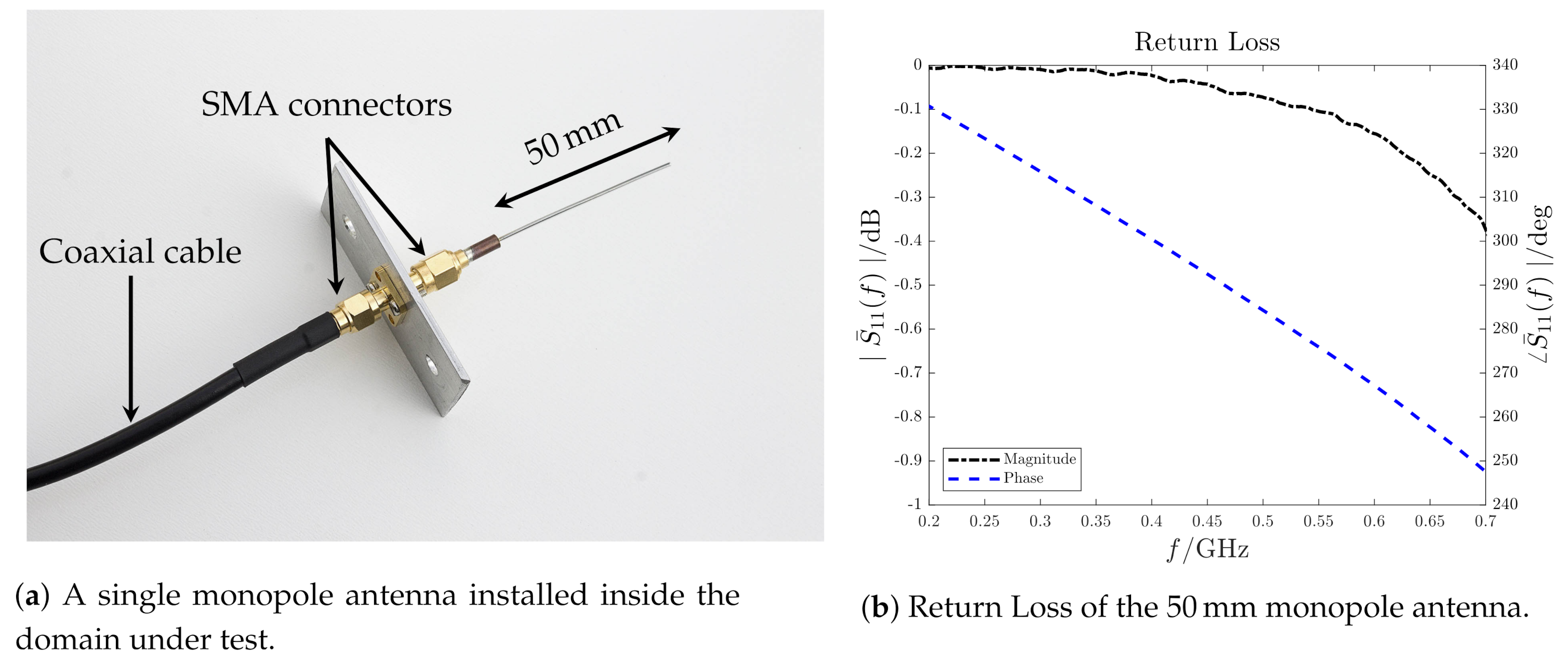
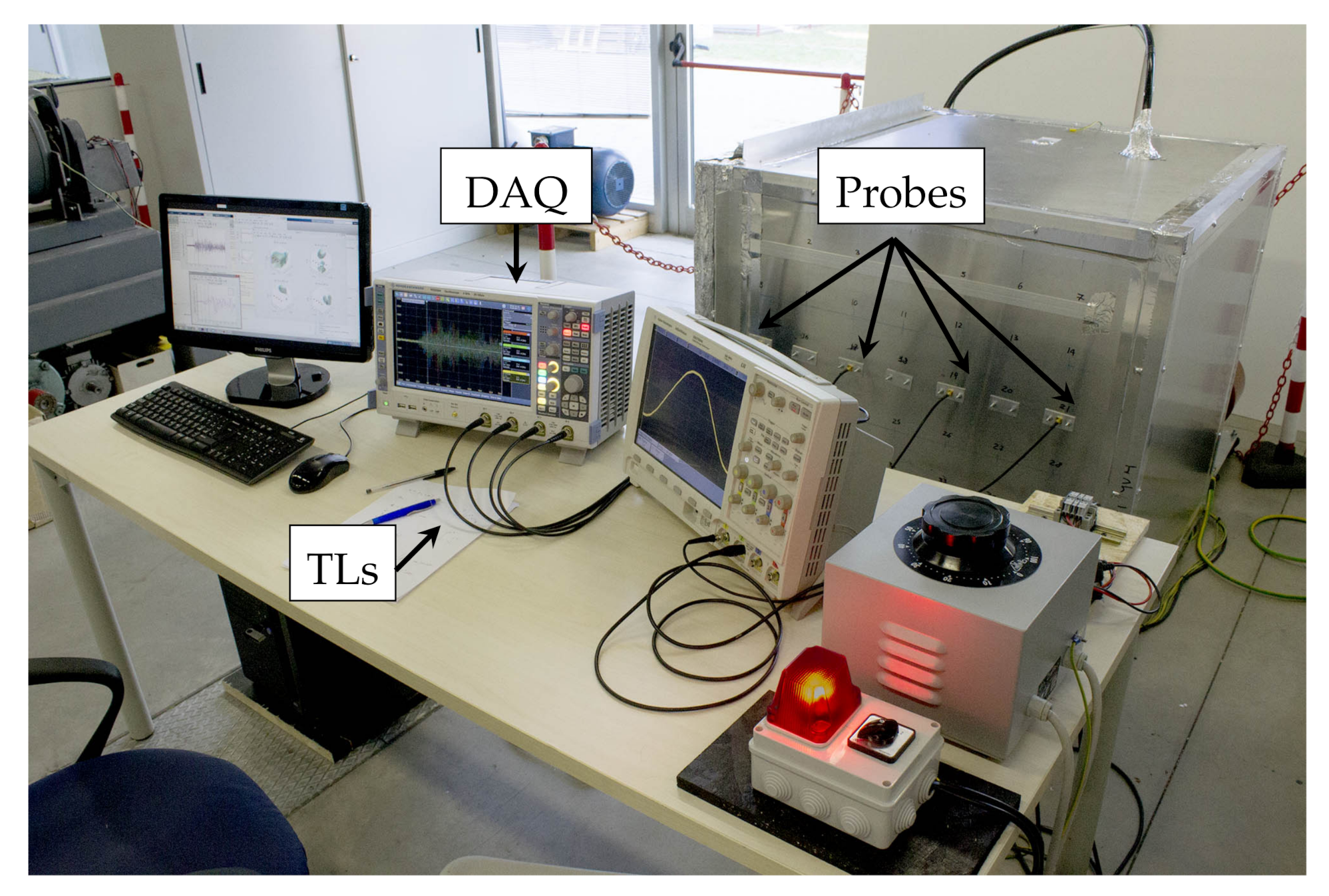
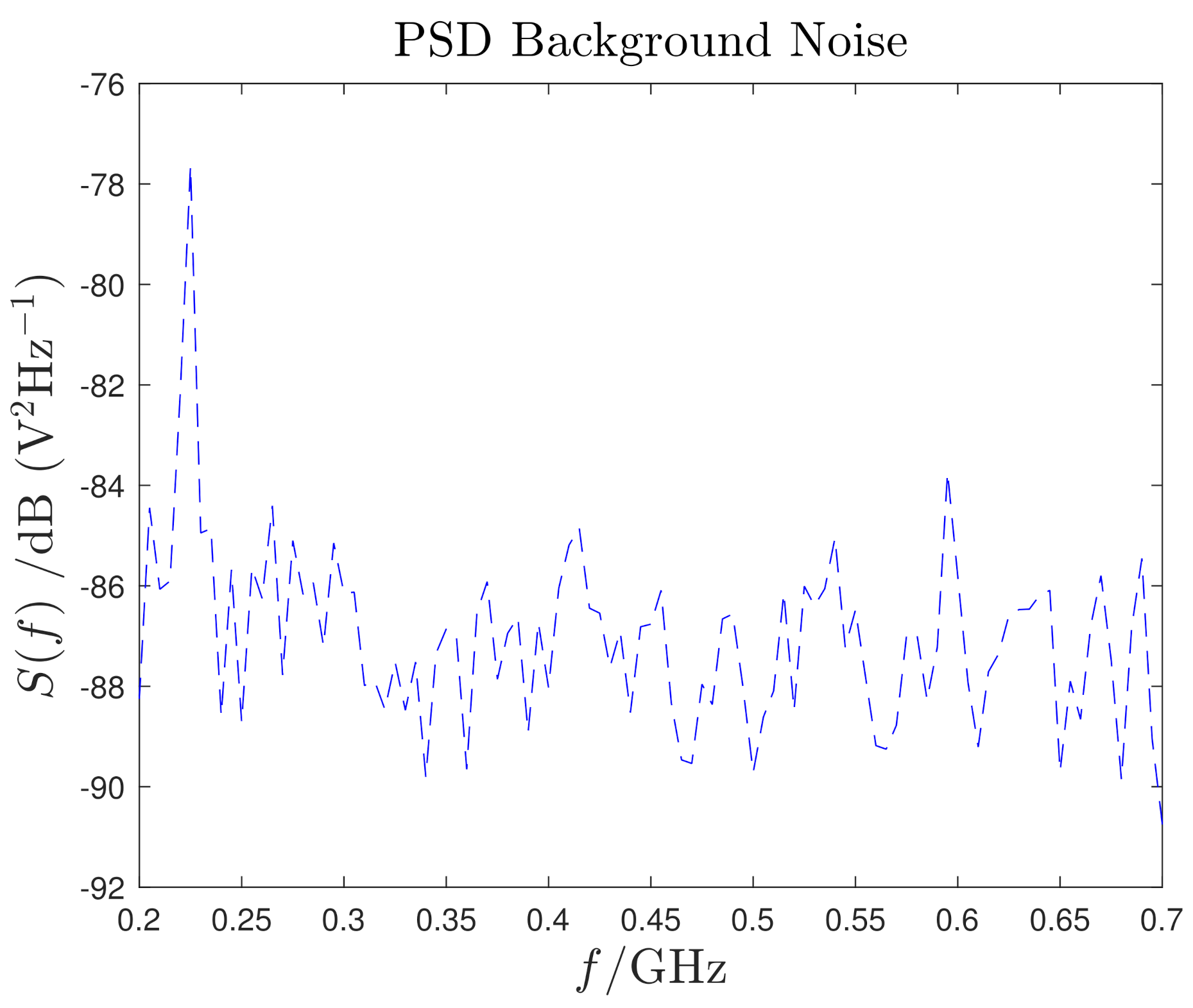


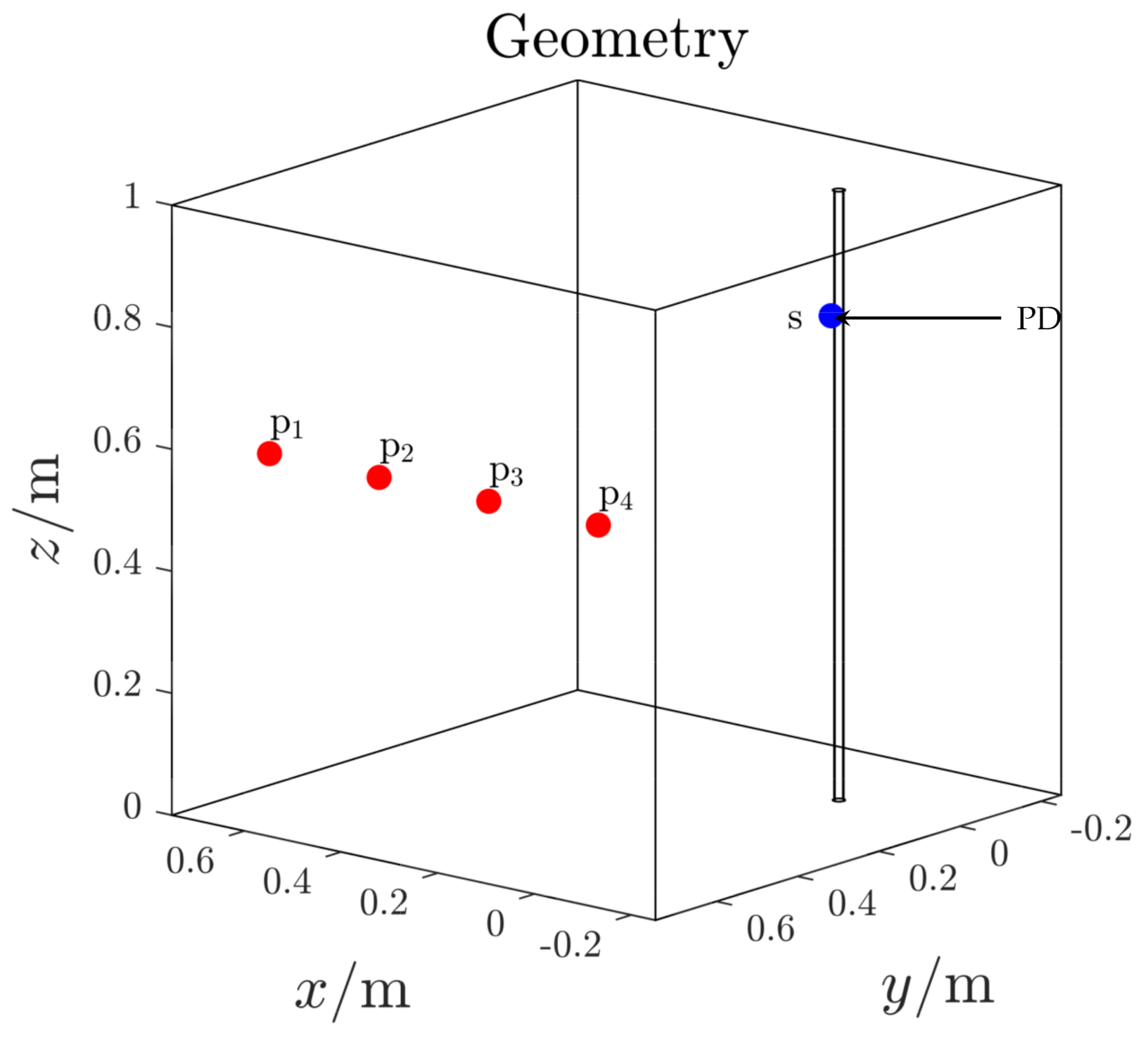


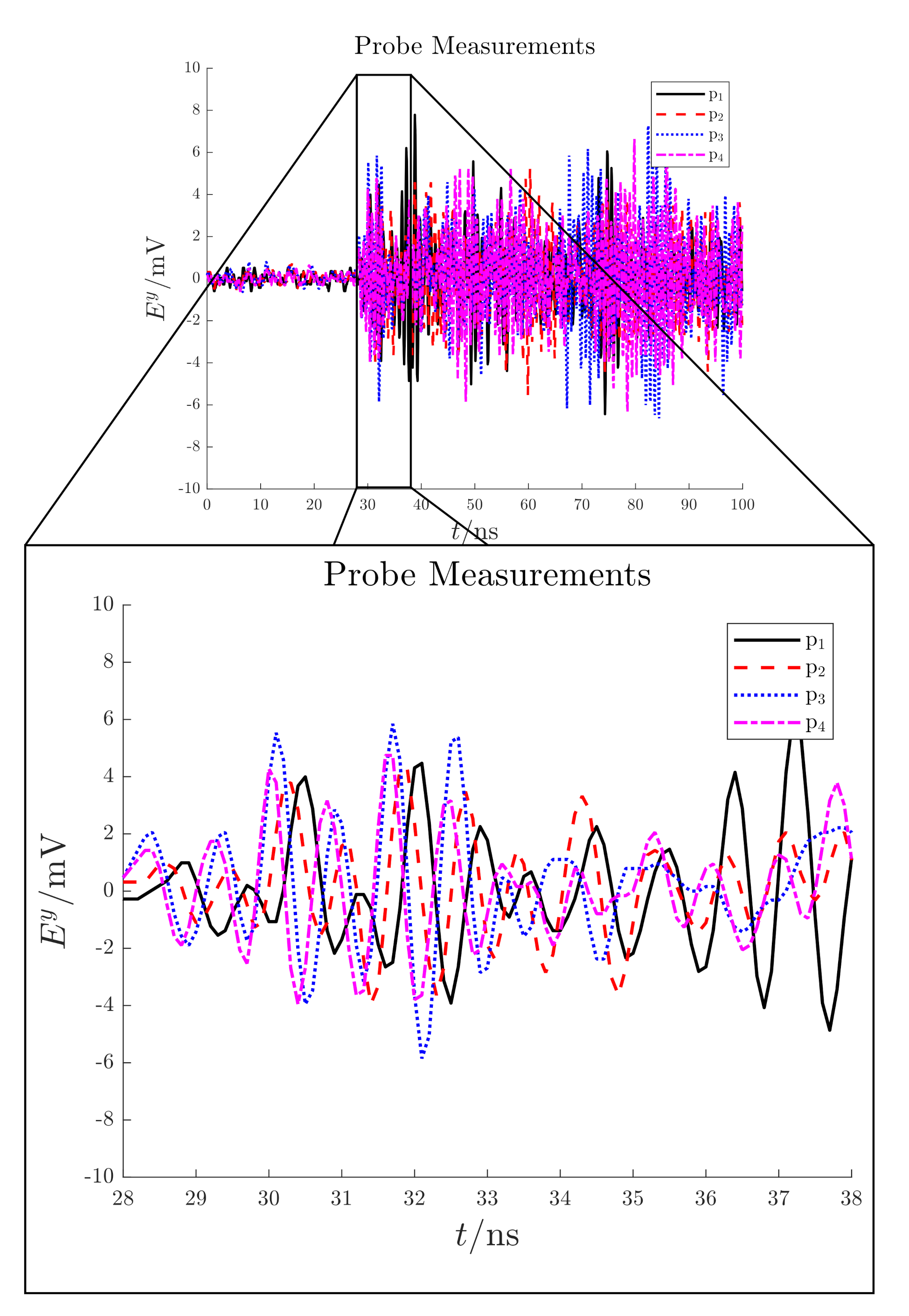
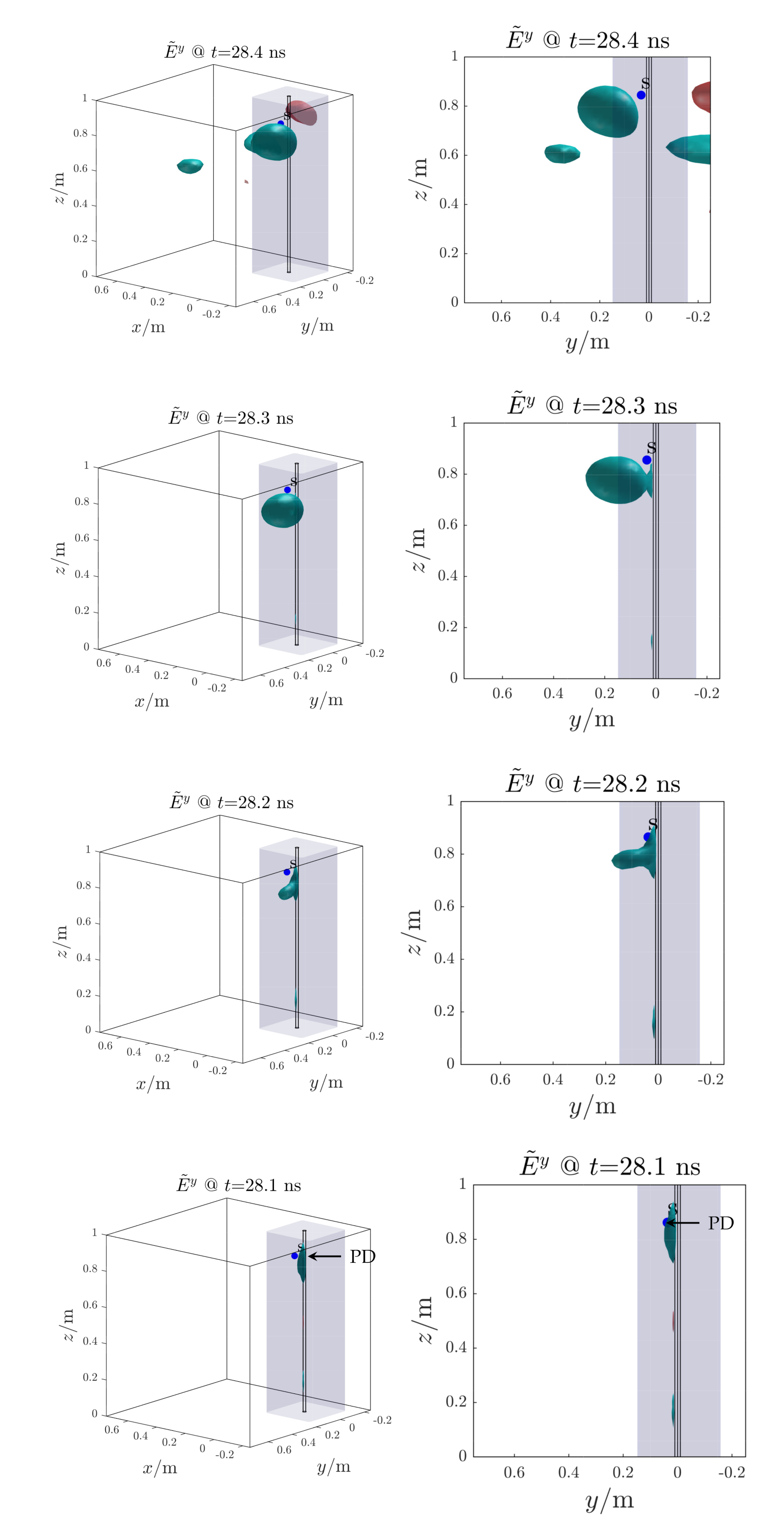
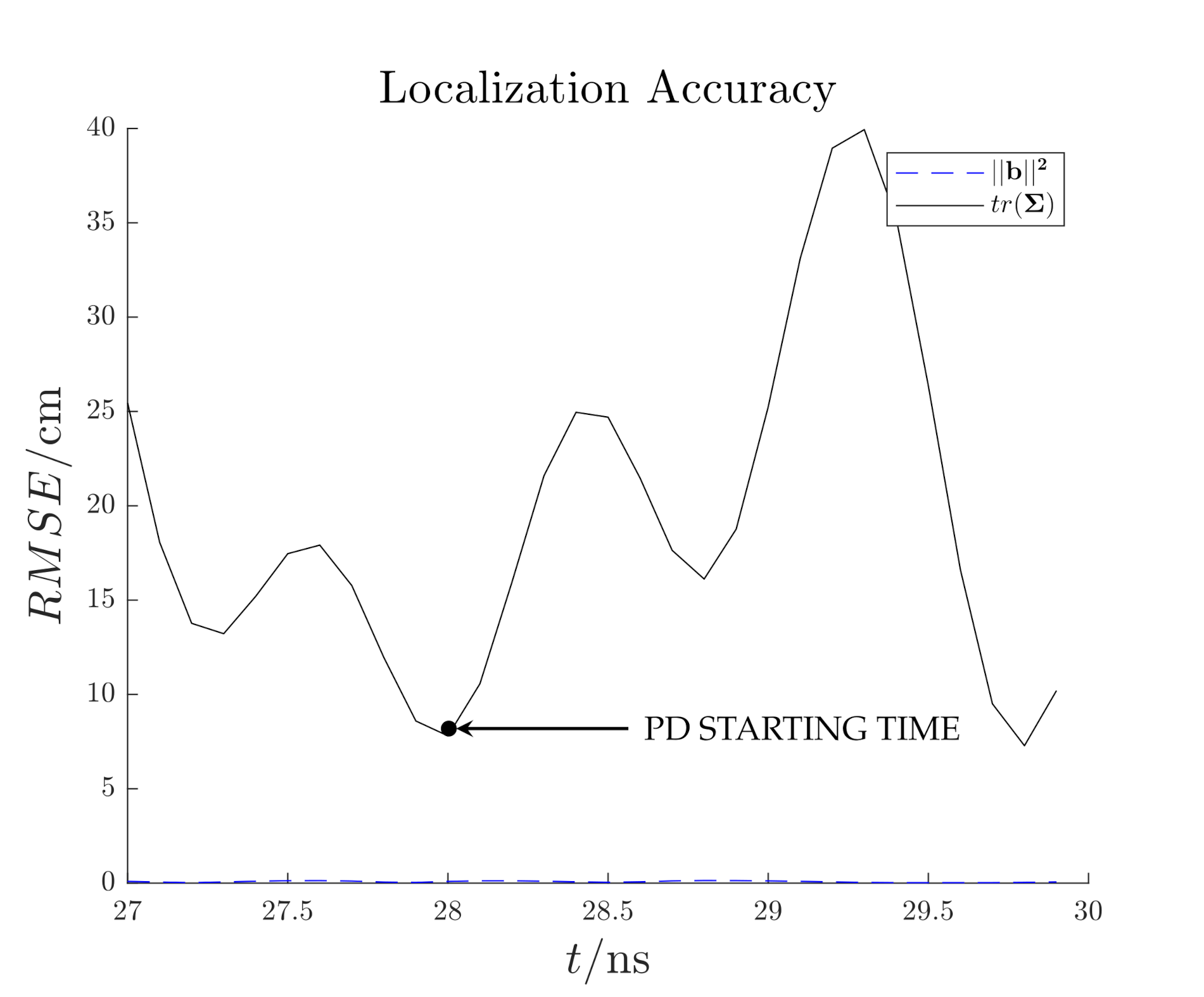
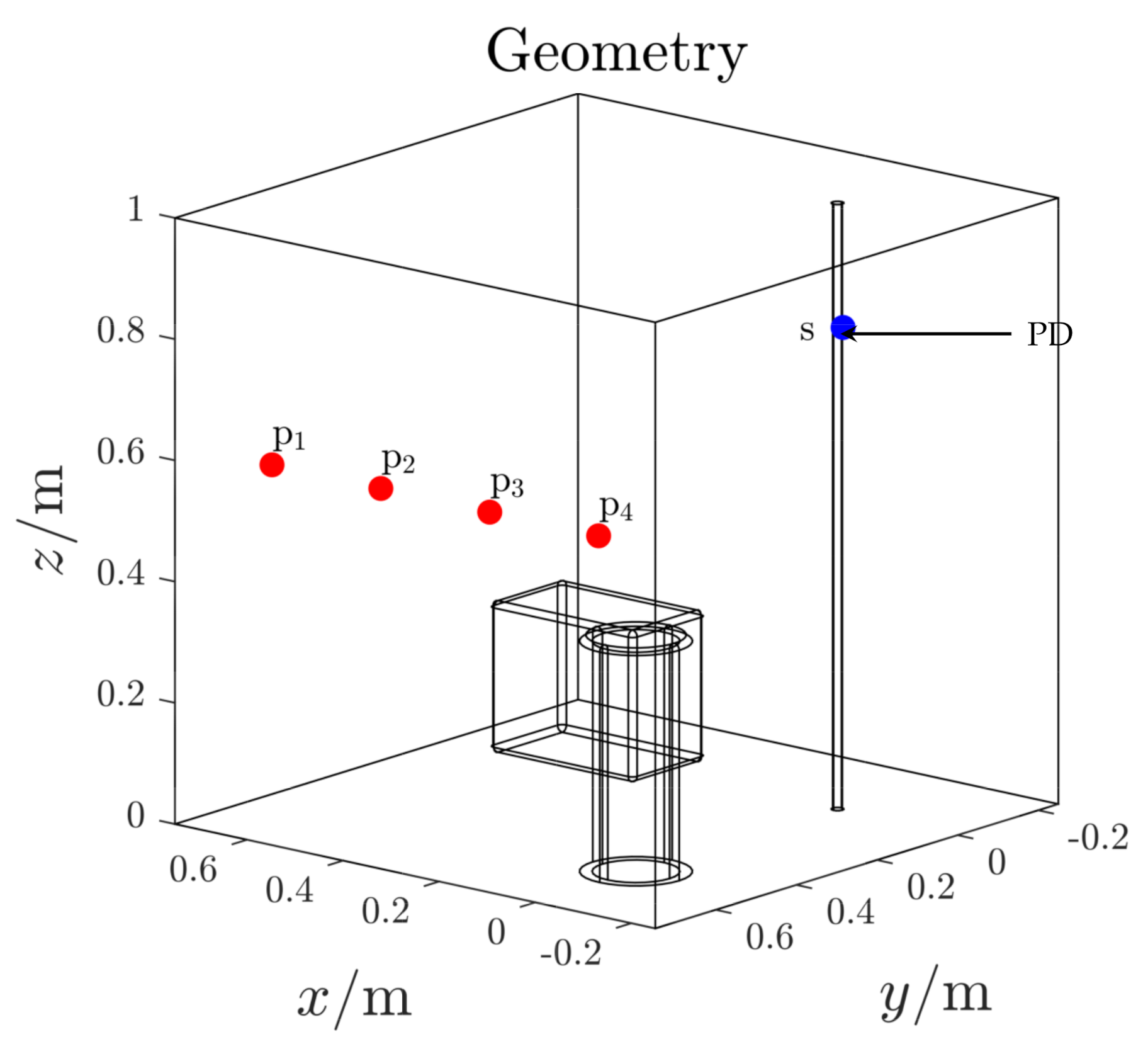
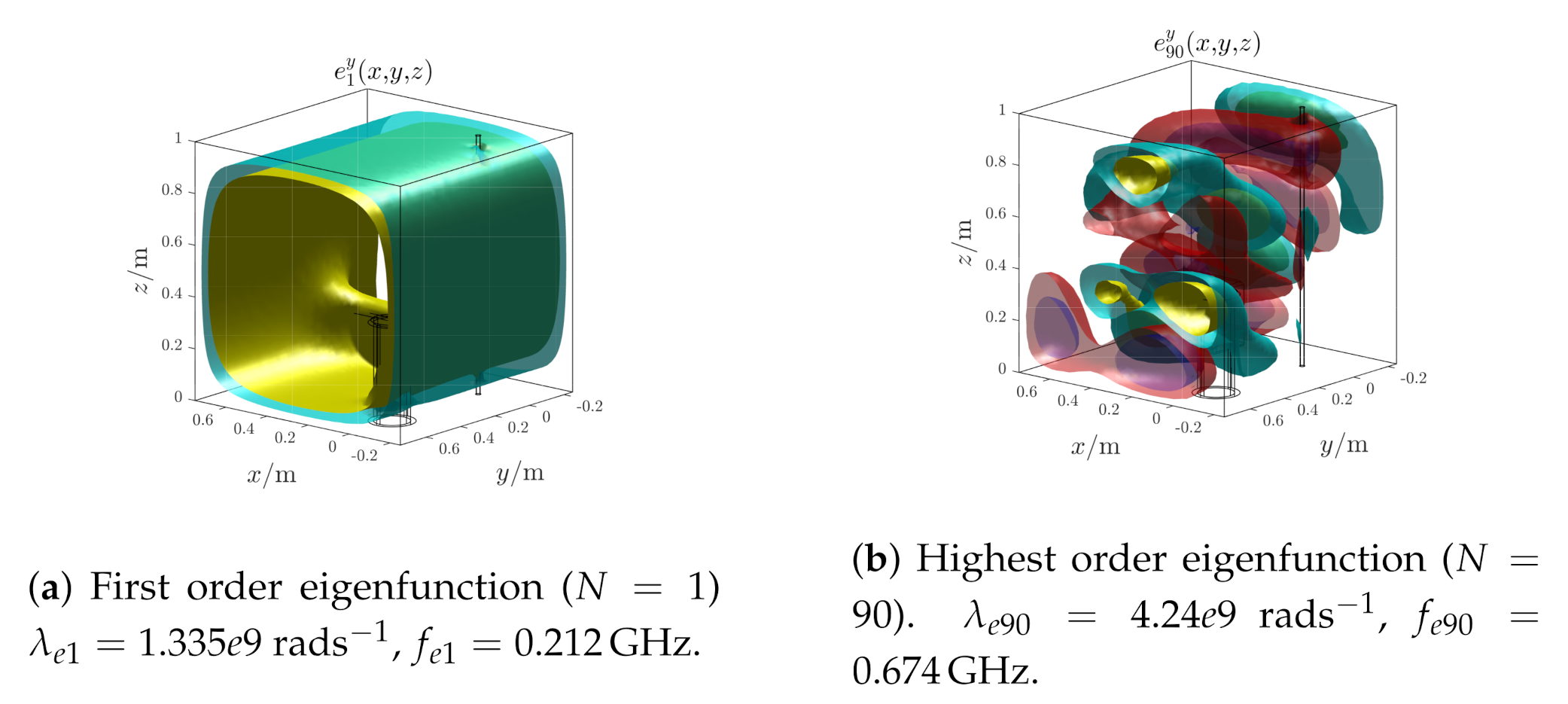


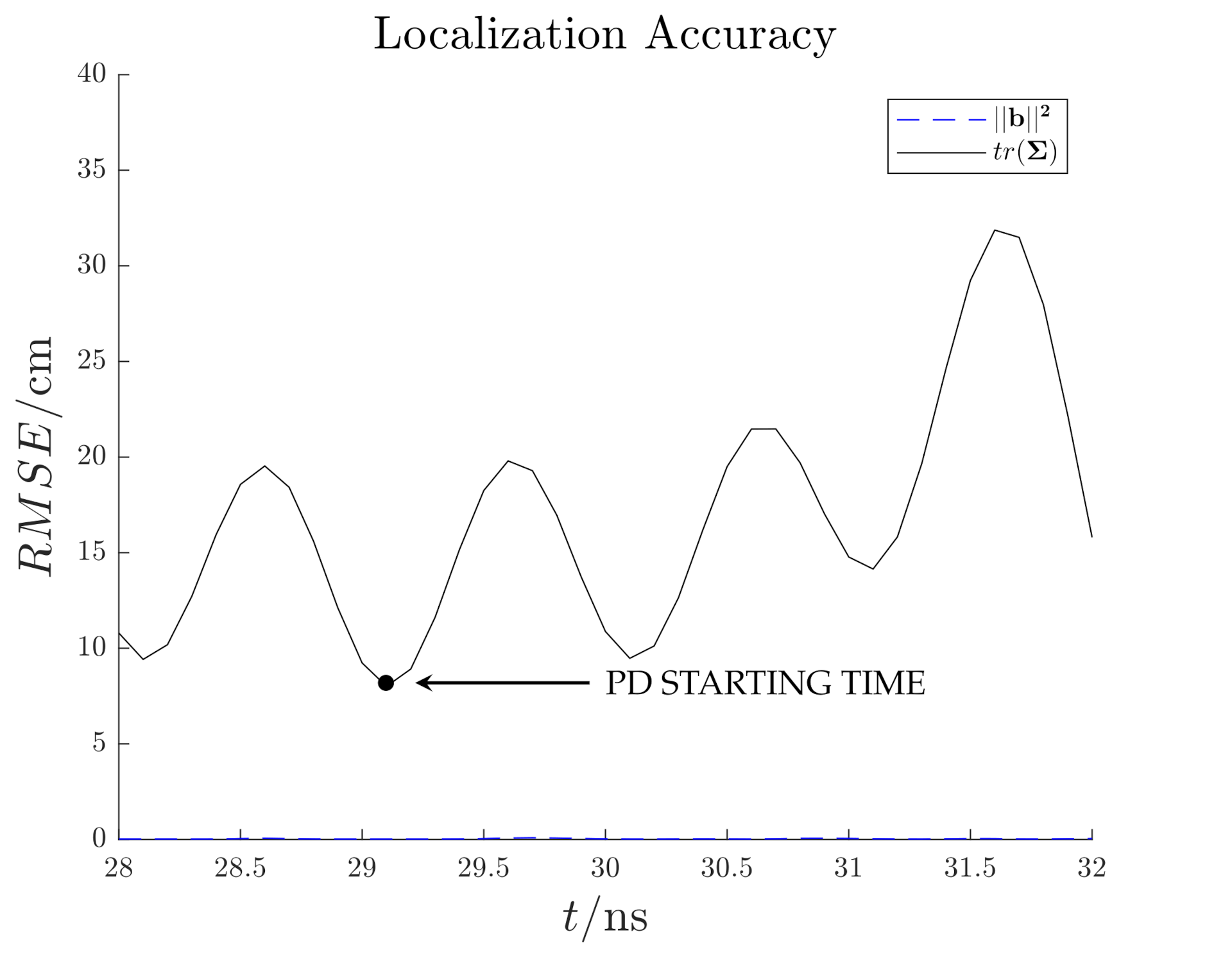
| Antenna | Location (x/m,y/m,z/m) |
|---|---|
| p | (0.59,0.70,0.61) |
| p | (0.36,0.70,0.61) |
| p | (0.14,0.70,0.61) |
| p | (−0.09,0.70,0.61) |
Publisher’s Note: MDPI stays neutral with regard to jurisdictional claims in published maps and institutional affiliations. |
© 2021 by the authors. Licensee MDPI, Basel, Switzerland. This article is an open access article distributed under the terms and conditions of the Creative Commons Attribution (CC BY) license (http://creativecommons.org/licenses/by/4.0/).
Share and Cite
Perfetto, L.; D’Antona, G. Experimental Results of Partial Discharge Localization in Bounded Domains. Sensors 2021, 21, 935. https://doi.org/10.3390/s21030935
Perfetto L, D’Antona G. Experimental Results of Partial Discharge Localization in Bounded Domains. Sensors. 2021; 21(3):935. https://doi.org/10.3390/s21030935
Chicago/Turabian StylePerfetto, Luca, and Gabriele D’Antona. 2021. "Experimental Results of Partial Discharge Localization in Bounded Domains" Sensors 21, no. 3: 935. https://doi.org/10.3390/s21030935
APA StylePerfetto, L., & D’Antona, G. (2021). Experimental Results of Partial Discharge Localization in Bounded Domains. Sensors, 21(3), 935. https://doi.org/10.3390/s21030935







